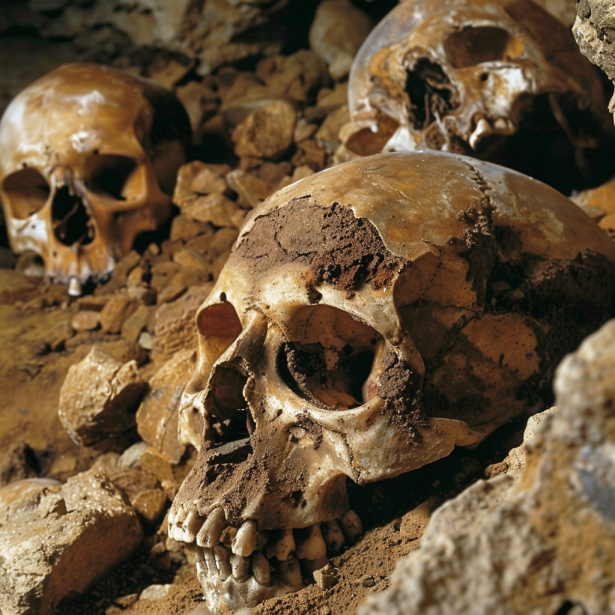Introduction
Deep within the Atapuerca Mountains in northern Spain lies a site of immense paleontological significance: the Sima de los Huesos, or ‘Pit of Bones.’ This ancient cave has yielded the remains of at least 28 individuals, dating back over 430,000 years, offering crucial insights into human evolution. Among these findings is the earliest known case of homicide, identified from the fractures on a skull known as Cranium 17. This chilling discovery not only provides a glimpse into the violent interactions of our prehistoric ancestors but also raises profound questions about the social dynamics and interpersonal conflicts that existed in ancient human communities.
The Discovery of the Sima de los Huesos
The Sima de los Huesos was discovered in the 1970s, but it wasn’t until the 1990s that extensive excavations began to uncover its true significance. The site has provided an unparalleled window into the Middle Pleistocene, a critical period in human evolution. The remains found here have been attributed to Homo heidelbergensis, an ancestor of both Neanderthals and modern humans.
Significance of the ‘Pit of Bones’
The Sima de los Huesos is considered one of the richest sources of hominin fossils in the world. The site has provided a wealth of information about the morphology, genetics, and behavior of our ancient relatives. The discovery of numerous well-preserved bones has allowed scientists to study the physical characteristics and health of these early humans in great detail.
Cranium 17: The Earliest Known Homicide
Among the many significant findings at the Sima de los Huesos, Cranium 17 stands out due to the evidence it provides of interpersonal violence. The skull exhibits two distinct fractures on the forehead, which forensic analysis suggests were caused by deliberate blows. The location and nature of these injuries indicate that they were unlikely to have been the result of an accidental fall or animal attack, pointing instead to a case of prehistoric murder.
Forensic Analysis and Evidence
The fractures on Cranium 17 were carefully analyzed using modern forensic techniques. Researchers concluded that the injuries were caused by at least two separate impacts from the same object. The consistency of the force and the precision of the blows suggest intentional harm inflicted by another individual.
Social Dynamics of Prehistoric Humans
The evidence of homicide at the Sima de los Huesos provides a unique glimpse into the social dynamics of our ancient ancestors. It raises questions about the nature of conflicts and violence in prehistoric communities. Was this act of violence driven by personal disputes, competition for resources, or other social factors? Understanding these dynamics can offer insights into the evolution of human behavior and social organization.
Life in the Middle Pleistocene
The individuals at the Sima de los Huesos lived during the Middle Pleistocene, a period characterized by significant climatic fluctuations and environmental challenges. These early humans had to adapt to varying conditions, which likely influenced their social structures and interactions. The presence of tools, evidence of fire use, and burial practices found at the site indicate a level of social complexity and cultural development.
Implications for Human Evolution
The findings from the Sima de los Huesos have profound implications for our understanding of human evolution. The evidence of violence suggests that social conflicts and their resolution may have played a role in shaping human societies. Additionally, the physical traits observed in the remains provide insights into the evolutionary path that led to modern humans and Neanderthals.
Ethical Considerations and Future Research
The discovery of the earliest known homicide also brings ethical considerations to the forefront. How should we interpret and present evidence of violence among our ancestors? Future research at the Sima de los Huesos will continue to explore these questions, using advanced technologies to uncover more details about the lives and deaths of these ancient individuals.
Conclusion
The ‘Pit of Bones’ in the Atapuerca Mountains offers a fascinating and sometimes grim glimpse into the lives of our prehistoric ancestors. The case of Cranium 17, with its evidence of the earliest known homicide, challenges our understanding of early human behavior and social dynamics. As research continues, the Sima de los Huesos will undoubtedly yield more secrets, enriching our knowledge of human evolution and the complex history of interpersonal relationships.
FAQs
What is the Sima de los Huesos?
The Sima de los Huesos, or ‘Pit of Bones,’ is a paleontological site in the Atapuerca Mountains of northern Spain. It contains the remains of at least 28 individuals dating back over 430,000 years.
Who were the individuals found at the Sima de los Huesos?
The remains found at the site are attributed to Homo heidelbergensis, an ancestor of both Neanderthals and modern humans.
What is significant about Cranium 17?
Cranium 17 shows two distinct fractures on the forehead, which forensic analysis suggests were caused by deliberate blows, indicating the earliest known case of homicide.
What does the evidence of homicide suggest about prehistoric humans?
The evidence suggests that interpersonal violence existed among prehistoric humans, raising questions about the nature of conflicts and social dynamics in ancient communities.
What insights do the Sima de los Huesos findings provide?
The findings offer valuable information about the morphology, genetics, health, and behavior of early humans, shedding light on human evolution and social organization.
What are the ethical considerations of studying ancient violence?
Studying evidence of ancient violence requires careful interpretation and presentation, considering the implications for understanding human behavior and evolution.

